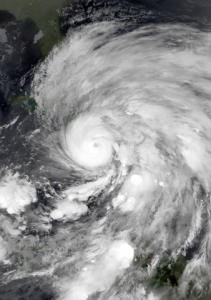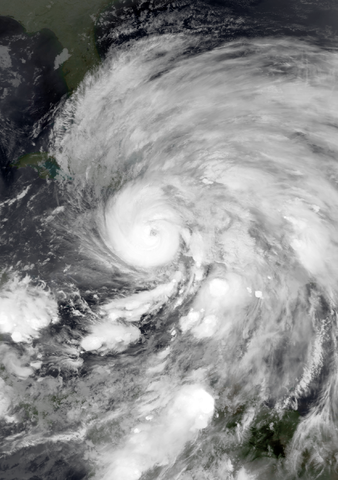For Newton, his thing was gravity. Oh, and Einstein, relativity. Well, Murphy, he has a law too and it goes something like this: “Whatever can go wrong, will.” Back to this in a moment.
But first. If you’re interested in/concerned about air quality matters, then you’ve probably also been closely following anything and everything global warming/climate disruption related.
So, according to Columbia University Climate Scientist Radley Horton and a contributing author to the National Climate Assessment (a painstaking report on climate released once every four years) on Friday, Nov. 3, 2017 in an on-the-air interview with PBS [Public Broadcasting System] Newshour anchor Hari Sreenivasan, over the last century, Earth has experienced a temperature rise of roughly one degree Fahrenheit.
We’ve seen the destruction in places like Texas, Florida and Puerto Rico caused by devastating hurricanes and ensuing floods. In fact, in a report on Sunday, Nov. 5th, on CBS’s [Columbia Broadcasting System] 60 Minutes, much of the island nation (its closest point, incidentally, located about 1,000 miles from the U.S. mainland), is still reeling from the effects of Hurricane Maria and has been without power some 46 days after the storm struck on Sept. 20th. Whereas most hurricanes impacting the territory skirt the island’s coasts, according to what I heard during this report, this latest event tore right through Puerto Rico’s center.
As for Hurricane Harvey, it dumped upwards of 50 inches of rain on parts of Texas. I’m still trying to get my head around how much rain that is. To release that much precipitation, it’s mind-boggling just thinking about how much water a cubic foot of atmosphere would have to contain and how many cubic feet of water in the atmosphere there would have to be to produce the kind of cumulative total rainfall that fell on the Texas Gulf Coast region (that is, in and around Houston). As far as I’m aware, these kinds of aggregate totals have not been seen since what happened in the Sacramento, California region in 1861-’62 – which it has been brought to bear was under 10 feet of water and which took at least six-month’s time before the water drained and the area started drying out – and dumped all in a matter of just days!

I wrote about such a catastrophe in “Modern-day ‘megafloods’: Is there an air pollution-atmospheric connection?” here.
In fact, in that post, I wrote: “Since it has been about 150 years since the 1861-‘62 megaflood occurred, one has to wonder when the next ‘big one’ will happen.”
With the addition of major weather events occurring in both 2009 and 2010, I also submitted: “I can’t help but wonder if we’ll be seeing more of these kinds of events or if air pollution is prompting temperature rise and if such rise could be a contributing factor.”
And who can forget the devastation wrought by Hurricane Sandy in 2012?!
No question we’ve seen a, if not, the “big one.”
What I do know is that with a rising global mean temperature, there is an increased tendency for increased water evaporation to occur that is, compared to what would be considered normal.
Hurricanes, monsoons and the like aren’t the only so-called “side effects” we’ve been seeing as of late tied to world warming.
Consider also the five-year drought the U.S. west suffered through, its official end so-declared barely two years ago.
Horton in the Newshour interview, meanwhile, added in this century so far, there have been double the number of extreme high-temperature events as there were low-temperature ones. And, it’s not that they’ve just been extreme: the events are record-breaking, Horton added. The climate scientist points out also there are coast-based communities witnessing a five-fold increase in coastal flooding frequency compared to what was encountered just two generations back.
So, in getting back to the earlier comment that “whatever can go wrong, will,” is Murphy’s law playing out in the sense that what we are seeing extreme weather-related-wise in this day and age, all on account of global temperature rise? And, if this Murphyism as applied to this particular situation turns out to be spot on, “then what?!” would be my next question.
That said, as a world community in erring on the side of caution it would seem there is everything to gain and nothing to lose, that is, save for a degree and quite possibly more; a reference to temperature, obviously. Sure makes sense to me!
Image above: NASA
– Alan Kandel

Makes no sense whatsoever. The “extreme” weather events of the recent past are much less often and much less severe than 50 – 100 years ago. Check your history.
Satellite and balloon data show the average temperature has not changed in the last 19 years, therefore blaming CO2 is nonsensical. CO2 is plant food not pollutant.
Cold is what kills. Again check your history.
Something you and others should know about the San Joaquin Valley.
I first moved to the Valley-based community of Fresno in 1977. What I can remember at that time and for years subsequent to this, every year during the fall and winter, this area was notorious for having dense fog. I mean without a rain event followed usually by short periods of clearing, the fog was relentless. Easily three months or more duration of dense fog would persist. And, in the Valley the widespread, dense fogs would first appear early-to-mid October. Not any more.
Not just this, but when there were days when in the late mornings or early afternoons where the sun managed to break through, revealed to the eye was this thick gunk mucking up the air. It wasn’t smog alone. Most probably it was laden with dirt and dust from agricultural plowing and/or harvesting activities and particulates from wood-burning. I’ve seen Los Angeles and Orange County smog, and the crud that I remember seeing here beginning every fall decidedly had a different appearance to it than that which I remember experiencing when I lived in the south coast region. It’s been a long while since I’ve witnessed what the Valley used to get in this regard.
Furthermore, responsible for the occurrence of fall and wintertime fog in the Valley are inversions. Cooler air is held close to the Valley floor and sitting above this is warmer air. The warmer air above prevents the cooler air below from, well, warming (mixing). High pressure is to account.
The way I understand things, due to the drought, conditions present which would ordinarily be ripe for fog formation, I’m just not seeing. Temperatures have been way warmer this time of year than what is typical. Sometimes different plant types I have in my yard bud and blossom more than once per year. And, certain plants I have that normally would have already shed their leaves, still have them. So, something has changed.
In trying to connect the dots I could say, well, because of the lack of rain in the Valley during the drought years, because there was below-normal rainfall (11.5 inches per year in Fresno is considered normal), this would no doubt account for the lack of widespread, dense fog. And, because of the lack of fog, it is reasonable to assume that fall and wintertime temperatures are going to be on the warmer side. But there is a problem with that: Between Oct. 1, 2015 and Sept. 30, 2016, Fresno received 14.29 inches of rain and between Oct. 1, 2016 and Sept. 30, 2017, Fresno received 17.36 inches – both above-normal precipitation amounts. Yet, still the lack of abundant and frequent fog episodes.
With that much rain, I would have expected the return of this dense, widespread fog. But, that never happened. From what I remember, last year there were maybe five days total where fog was present. And, it seemed when we did get fog, it lifted rather quickly. No fog this year so far.
So, I would ask: What has changed? Why the lack of dense, widespread fog episodes?
This would be a good study for a research body to undertake to try to explain the change.
Incidentally, today’s high temperature? 74.